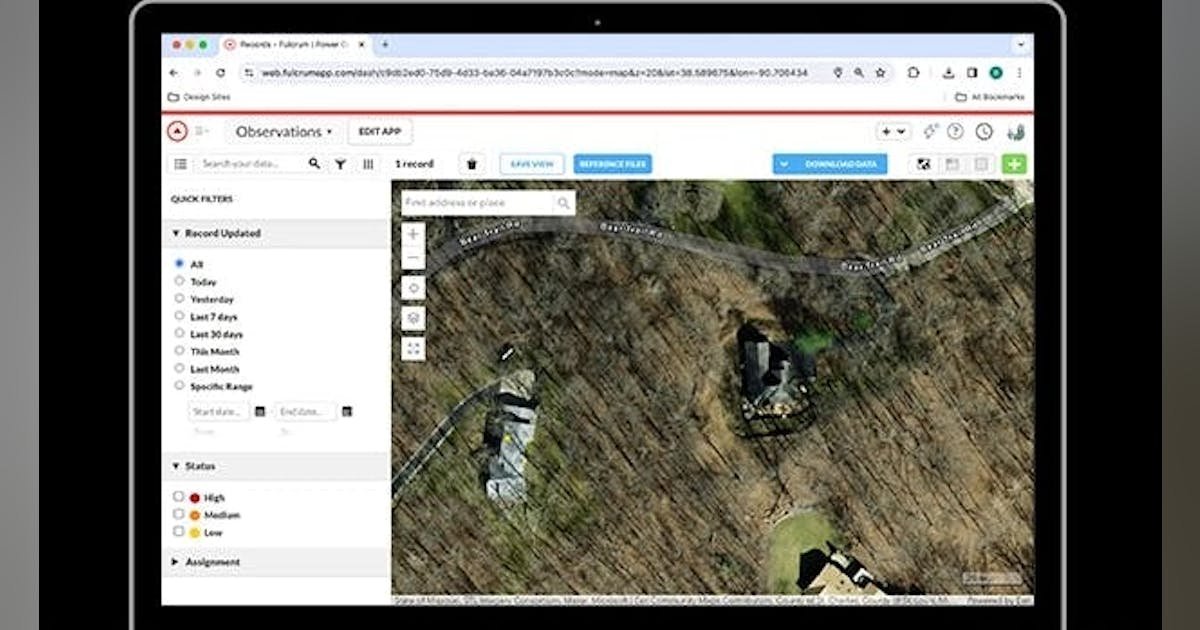Business
How a race for electric vehicles threatens a marine paradise

Science correspondent, BBC News
 Global Witness
Global WitnessStark images, captured from a drone by environmental campaigners and shared with the BBC, appear to show how nickel mining has stripped forests and polluted waters in one of the most biodiverse marine habitats on Earth.
The Raja Ampat archipelago – a group of small islands in Indonesia’s Southwest Papua Province – has been dubbed the “Amazon of the Seas”.
But mining for nickel – an ingredient in electric vehicle batteries and in stainless steel – has ramped up there in recent years, according to the organisation Global Witness.
In a move that was welcomed by campaigners, the Indonesian government this week revoked permits for four out of five mining companies operating in the region.
 Global Witness
Global WitnessIn a statement published online, Indonesia’s Ministry for the Environment said: “Raja Ampat’s biodiversity is a world heritage that must be protected.
“We pay great attention to mining activities that occur in the area.”
But photographs – taken by Global Witness as part of an investigation – appear to show environmental damage already done.
Aerial images show forest loss and sediment run-off into waters that are home to biodiverse coral reefs.
Global Witness told the BBC that land use for mining, across multiple small islands in the archipelago, increased by 500 hectares – equivalent to about 700 football pitches – between 2020 and 2024.
 Global Witness
Global WitnessSome conservationists, including the organisation Greenpeace, are concerned that the government’s decision could be reversed by legal action by the mining companies.
And one company that operates on Gag island, which has particularly rich deposits of nickel, has been allowed to continue its operations. The government said it would order the “restoration of the ecological impacts that occur” there.
Coral reef conservationist and ecologist Dr Mark Erdmann told BBC News that he was “blown away, and so happy” about the government’s decision to revoke the mining permits.
“This is the global epicenter of marine biodiversity,” he told BBC News.
Dr Erdmann has worked in Raja Ampat for more than two decades and helped set up the network of marine protected areas there. He is one of the founders of a shark rewilding project, called ReShark, based in the region.
He added: “It was a voice of outrage from the Indonesian people that made the government pay attention.”
But this ecological controversy is an example of how the demand for the metals needed to power battery technology – for electric cars and other low carbon energy sources – can damage the environment.
 Global Witness
Global WitnessIndonesia now accounts for more than half of the world’s nickel mine production, according to a report last year by the Institute for Energy Economics and Financial Analysis.
And while the beauty and biodiversity of the Raja Ampat has drawn attention to mining activity there, mining has been linked to ecological damage elsewhere too.
A 2024 study by Forest Watch Indonesia found a link between the loss of forests associated with mining activity and increased local flooding and landslides.
 Global Witness
Global WitnessIncreasing demand for so-called critical minerals is shaping economic decisions around the world. It was the driving force for President Trump’s recent executive order to jumpstart the mining of metallic nodules from the deep sea in international waters. It is a move that China has called illegal.
Dr Erdmann pointed out that balancing economic growth with environmental protection was a particular dilemma for Indonesia. “It has a lot of nickel – one way or the other, some of it’s going to come out of the ground,” he said.
Dr Michaela Guo Ying Lo, from the Durrell Institute of Conservation and Ecology (Dice) and the University of Kent, led a study in 2024 of the impact of mining on local communities in Sulawesi. The large Indonesian island has most of the country’s nickel deposits.
The research showed that mining activity reduced poverty slightly, but that there was significant “worsening of environmental well-being” including increased local water and air pollution.
“Indonesia is positioning itself globally in the nickel market,” Dr Lo told BBC News. “But it’s important not to forget what’s happening locally.”
 Global Witness
Global WitnessImam Shofwan, an environmental campaigner from an organisation called Jatam, based in Jakarta, told BBC News: “They say nickel is a solution to the climate crisis. But it’s causing deforestation and destroying farmland.”
He also pointed out to the BBC that low-lying coastal areas, where some nickel deposits are found, are some of the places most vulnerable to the effects of climate change, including rising sea levels.
Dr Erdmann commented: “The nickel dilemma is a horrible one.
“Mining is always going to be environmentally impactful and we all tend to think that electrification is a good idea. But what is the acceptable damage that we’re willing to see?”
The BBC contacted the Indonesian government for comment, but did not receive a reply.
 Global Witness
Global WitnessBusiness
Spain’s digital business school ISDI & Microsoft bet on AI in executive MBAs •

Keep up to Date with Latin American VC, Startups News
At a time when artificial intelligence (AI) is redefining work, ISDI, Spain’s digital business school, and Microsoft have formed an alliance to incorporate the real-world use of generative AI into executive training.
According to Microsoft’s Workplace Trends Report, 50% of executives in countries like Spain believe that training their teams in the use of AI will be key in the next five years.
For this reason, ISDI says it is seeking to connect theory and practice in an academic environment that adapts to the challenges of digital transformation.
Microsoft, for its part, brings its technological expertise so that artificial intelligence becomes a tangible, competitive resource for MBA grads.
“We want to train complete professionals, capable of leading business transformation in a context marked by AI,” said Basola Vallés, Executive Director of ISDI, through a press release.
The business school has faculty and alumni from around the world, including Latin America, and has an international campus in Mexico.
Creating AI Agents
The module, titled Crea tu Agente IA (Create your AI Agent), unfolds over five milestones in the master’s degree: from agent activation in Microsoft’s Copilot Studio, to application in real projects, simulation of strategic scenarios and career development.
Upon completion, each participant will have a trained and operational AI agent ready to accompany the student beyond the classroom. This practical approach contrasts with theory-focused programs by integrating AI into the day-to-day work life.

With this initiative, the Executive MBA in Business and Technology (MIB) is positioned as the first Executive MBA in Spain to structurally integrate business, technology, artificial intelligence and human development, according to the university.
Paco Salcedo, president of Microsoft Spain, added: “Our technology is designed for students to turn AI into a real advantage for their organizations”.
The proposal is reinforced with a project linked to business challenges and with an employability component.
A study by LinkedIn and Microsoft reveals that professionals who mention AI in their profiles are 17% more likely to be considered in selection processes.
The impact of the program has already been recognized by several media, which places it amongst the most influential executive master’s programs in Spain.
MIB graduates record an average salary increase of 38% in the year after graduation and 70% job mobility, according to figures shared with Contxto that reflect how the combination of business, technology and now generative AI can transform a career path.
According to a report published by Intel and analyst firm IDC, just 14% of Latin American companies have adopted AI agents in their work processes, putting the region in need of adapting to today’s challenges.
This trend of MBA programs that prioritize the use of generative AI could help to motivate future business leaders in the region and will hopefully boost the adoption figures of this technology in the coming years.
Keep up to Date with Latin American VC, Startups News
Business
Innovative AI Solutions Transforming Business Operations and Customer Interactions

Fulcrum (www.fulcrumapp.com) field-focused process and data collection platform for geospatial field processes and data collection recently launched Audio FastFill, a voice-powered, multi-field AI data collection tool.
It integrates advanced AI within the platform to create a textual scribe for field teams, eliminating inefficiencies of manual entry, and allows users in the field to dictate forms naturally and produce richer more actionable data input, with the system understanding and accurately populating fields.
Fulcrum dynamically understands context to populate complex fields like picklists and conditional logic, eliminating inefficiencies of manual entry and simplifying workflow, helping ensure ease of use in demanding environments. It can also dissect one continuous audio file to place all of the information into the correct corresponding fields and input to fields that aren’t text, like numbers or drop-down lists.
Pricing: structure not actual cost, free demo, free trial.
AIPhone
AIPhone (www.aiphone.ai) is a cross language calling app utilizing AI translation. It translates phone calls in real time—speak in your language and the other party hears it in theirs instantly and vice versa. How it works: you invite anyone via a simple link—no extra app needed for them.
The app, which supports several dozen languages and dialects, is trained to both translate words and understand the context behind them. In addition, it also supports camera translation—snap a photo or select a saved image (e.g. a sign) and get instant translation. It also translates video and voice calls in WhatsApp and other apps.
Pricing: weekly, monthly, annual plans available with free trial package available through X, TikTok, and Facebook.
ServiceMonster
ServiceMonster management software (www.servicemonster.com, 888/901-3300, covered in September 2022 column) recently introduced the ServiceMonster Payments mobile app, which features capabilities that facilitate both immediate branded invoicing that can be sent by email or text and collection of payments via credit cards, debit cards, and ACH. Suitable for solo operators and multi-crew service businesses, it has the ability to automate reminders and follow-ups. You can store cards on file securely for repeat customers or recurring billing.
ServiceMonster Payments includes built-in surcharging, allowing you to legally pass along credit card processing fees to your customers where permitted by law. Surcharging is automatically configured during setup based on your location. Most credit card and debit card transactions are deposited into your bank account in as little as two business days. The solution Payments offers an integration with QuickBooks Online and QuickBooks Desktop. A demo is available.
Plannit
Plannit (www.plannit.io), covered in August 2021 column, recently added a smart call answering system designed to function as a virtual assistant, handling calls when team members are unavailable. The system, which is available 24/7 and has multi-language support, features intelligent call routing, utilizing advanced algorithms to direct calls to appropriate departments or personnel based on predefined criteria.
Users can customize menu options and the software, which can take messages, can be programmed to answer FAQs. It can also qualify and prioritize prospective customers by asking questions and recording their answers and saving them in the messaging center as audio files. The service requires a new phone number acquired by Plannit, but calls to existing business numbers can be redirected for message taking when needed.
Gorilla Desk
Update: Gorilla Desk (www.Gorilladesk.com), initially covered in January 2025 tech column, has several new AI Agents to its platform (both desktop and mobile app) which are designed to heighten proficiency of field service management and handle customer interactions across multiple channels, including SMS, Web Chat, VOIP phone, and client portals.
The new capabilities, available on the customer portal and by text message, enable customers to book services 24/7, with the solution streamlining and automating the entire process, from inquiry to booking and confirmation, as well as route planning and optimization.
How it works: you embed your AI agent options directly on your web site and, as desired, your customer initiates the process by making contact with your embedded company AI receptionist through one of those portals, facilitating making, logging, and finding all calls without jumping among apps; the Client Portal Agent enables customers to request new work securely and view previous documents anytime. Gorilla Desk will notify you via in-app and email alerts whenever a new work request is submitted.
There are two types of AI conversations: static and dynamic. Static conversations provide general Q&As with informational responses. Dynamic conversations involve the system taking actions, such as capturing new lead info or scheduling a pending booking. (Pricing: $1.00 per completed static conversation, $1.75 per completed dynamic conversation.)
Gorilla Desk also has four new agents in the works: Kong AI (Supreme Intelligence), acting as the central intelligence, which will provide advanced analytics and generate custom reports; Mantis AI (Ops & Admin), which will automate the role of administrator and help run day-to-day operational workflows flawlessly; Atrax AI, which will help you deploy your website, aiding in page generation and optimization; Lotus AI (Customer Sentiment), which focuses on delivering analysis of customer standpoint so you know what conversations need real human attention; and SMS & Customer Portal Agents, enabling 24/7 handling of incoming customer SMS messages their conversations with your AI.
Business
Your browser is not supported
democratandchronicle.com wants to ensure the best experience for all of our readers, so we built our site to take advantage of the latest technology, making it faster and easier to use.
Unfortunately, your browser is not supported. Please download one of these browsers for the best experience on democratandchronicle.com
-

 Business2 weeks ago
Business2 weeks agoThe Guardian view on Trump and the Fed: independence is no substitute for accountability | Editorial
-
Tools & Platforms1 month ago
Building Trust in Military AI Starts with Opening the Black Box – War on the Rocks
-

 Ethics & Policy2 months ago
Ethics & Policy2 months agoSDAIA Supports Saudi Arabia’s Leadership in Shaping Global AI Ethics, Policy, and Research – وكالة الأنباء السعودية
-

 Events & Conferences4 months ago
Events & Conferences4 months agoJourney to 1000 models: Scaling Instagram’s recommendation system
-

 Jobs & Careers2 months ago
Jobs & Careers2 months agoMumbai-based Perplexity Alternative Has 60k+ Users Without Funding
-

 Podcasts & Talks2 months ago
Podcasts & Talks2 months agoHappy 4th of July! 🎆 Made with Veo 3 in Gemini
-

 Education2 months ago
Education2 months agoMacron says UK and France have duty to tackle illegal migration ‘with humanity, solidarity and firmness’ – UK politics live | Politics
-

 Education2 months ago
Education2 months agoVEX Robotics launches AI-powered classroom robotics system
-

 Funding & Business2 months ago
Funding & Business2 months agoKayak and Expedia race to build AI travel agents that turn social posts into itineraries
-

 Podcasts & Talks2 months ago
Podcasts & Talks2 months agoOpenAI 🤝 @teamganassi


